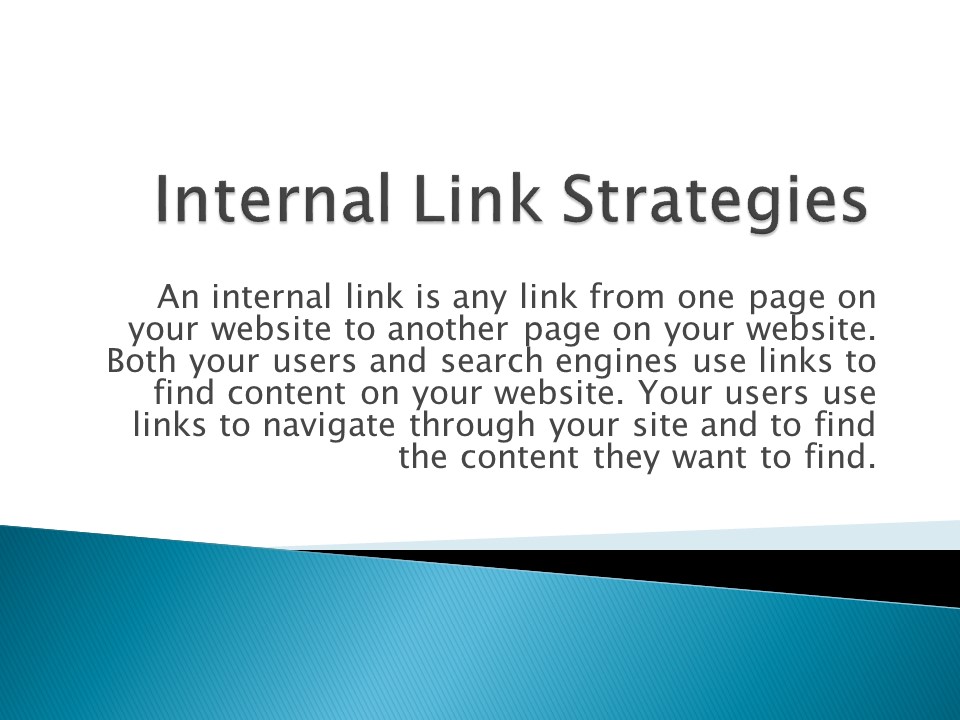Internal Link Strategies - PowerPoint PPT Presentation
Title:
Internal Link Strategies
Description:
Here we discuss about Internal Links Strategies – PowerPoint PPT presentation
Number of Views:1
Title: Internal Link Strategies
1
Internal Link Strategies
- An internal link is any link from one page on
your website to another page on your website.
Both your users and search engines use links to
find content on your website. Your users use
links to navigate through your site and to find
the content they want to find.
2
Why Internal Links are important for Seo
- 1. Internal links build your pages authority.
- 2. Internal linking makes people stay longer on
your site. - 3. Internal links work to create a good site
architecture.
3
Types of links
- Navigational links-Navigational links are used
to help users navigate through your website
pages. They are site-wide links that define what
kind of structure your site has. - Contextual Links-Contextual links are your
content links pointing to related articles and
topics. Thanks to contextual links, your pages
get better linked internally, so users want to
read more and stay longer on your site. Thanks to
that, you reduce the bounce rate and increase
user engagement.
4
Types of links
- No follow Internal Links-It is quite common to
have the nofollow attribute to disguise an
unnatural link to an external domain. The same
way some people use nofollow on internal links.
For example, nofollow tags are added on comments
to avoid user-generated content with spammy links
that might disrupt the site authority. - Do follow Links-Dofollow links are those that
allow Google and other search engines to point
back to your website or blog. So, every time you
insert a dofollow link on your site, it can point
back to you, which strengthens your authority by
showing search engines what other sites, blogs,
and posts are linking to you. - Help Links-This is a good place for contextual
links that lead to context-specific resources
with useful information related to the topic of
the source page.
5
Some Important Internal Link
Strategies
- 1. Keep a shallow website structure.
- 2. Make sure all the important pages are linked.
- 3. Keep the number of links per page reasonable.
- 4. Make sure image links have alt attributes.
- 5. Place contextual links within the main
content. - 6. Target Low volume Keywords with Internal
Links
6
Keep a shallow website structure
- It is considered a good practice when each page
can be reached within three clicks of the
homepage. Nowadays, users are very demanding when
it comes to the speed of websites, including page
load time and the time required to complete
certain actions. Why should one bother to get
through tens of unnecessary links if there are
plenty of similar websites out there with
well-organized and efficient internal pages?
Thus, it is crucial to reduce the number of
clicks it takes to get to important landing pages
and to maintain a shallow website structure
7
Make sure all the important pages are linked
- These days, search engines rely on both sitemaps
and links to discover web pages. It means that
even unlinked pages (otherwise known as orphan
pages) can be found by the search engines as
these pages are listed in the sitemap. But it's
impossible to find an orphan page through the
website's navigation. Such pages virtually don't
exist for the users. It's a good idea to get rid
of orphan pages by creating internal links to
them from other pages.
8
Keep the number of links per page reasonable
- The more links, internal or external, are found
on a page, the less link juice each link sends to
the page it points to. Moreover, unless the
content is well-structured, it may be boring for
your visitors to scroll down an endless list of
resources. Thus, if you want to send more
'ranking power' to pages you link to, reduce the
number of outgoing links.
9
Make sure image links have alt attributes
- The alt attribute of image links acts like anchor
text for text links so it's another opportunity
to send a ranking signal to search engines,
increasing authority while you're at it.
10
Place contextual links within the main content
- The links placed within the page's content have a
higher SEO value than the ones in the header,
footer, or sidebar. The latter has more to do
with navigation, and it looks like Google treats
those as non-editorial links. Link in the main
content, on the other hand, adds new information
and value to the text. Furthermore, the text and
keywords surrounding content links also matter
for the ranking of the target page.
11
Target low-volume keywords with internal links
- Instead of targeting a few high-search-volume
keywords, you may prefer to hunt for many
long-tail, low-search-volume keywords. In most
cases, they belong to the bottom level of a
website, e.g., individual blog posts or product
listings.































